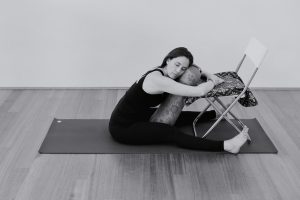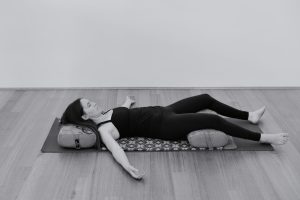
Restorative Yoga at Home: Theory & Practice
(Join me for a Spring Flourish Mini Retreat Saturday September 7th with Restorative Yoga!)
Last year we (re)introduced a restorative yoga practice to our schedule at Yoga Space each Friday at 5:30 called Freedom Fridays (timetable here). We felt strongly a restorative class belonged on our timetable because the reality for many people is that modern life can be very stressful. We are overstimulated by competing demands in our professional and personal lives and even while driving our senses are now further overloaded as cities embrace flashing neon signs near motor ways. We have phones and technology at the tips of our fingers and while this connectivity is wonderful in many ways, it can disrupt our connection to the present moment and leave us depleted from always being ‘ON’.
Always being ‘ON’ means that our nervous systems are wound up and we can find it really difficult to wind down. Often without consciously realising it there is a stress reaction cycle underway at a physiological and an emotional level and we seek out ways to ‘relax’. However the means commonly chosen to wind down, for example a glass of wine after work or binging Netflix, are actually not having the desired effect. A glass of wine might help you feel better in the moment but does not address the root cause of why you feel the way you do.
I believe it is powerful to begin to understand what is happening in our nervous system and the ways in which yoga can help.
The life that we lead, rushing to get kids to school or day care, rushing to work, the stress of studies or exams can very much bring about the fight or flight response. When this occurs our breathing rate increases, our blood pressure increases, our adrenaline increases, and we experience a sensory overload and become hyper vigilant to perceived threats. At the same time when we’re in this fight or flight system, our thought processes can change, our creativity lessons. Sometimes it’s hard to concentrate for longer periods of time and certainly our immune and digestive system react negatively to the constant stress reaction cycle we may be living in.
In terms of the science we are talking about is the difference between the parasympathetic nervous system and the sympathetic nervous system. Through understanding these two different yet related systems we can begin to understand how our practice can support our nervous system.
Sympathetic Nervous System
The sympathetic nervous system is one of the divisions of the autonomic nervous system and it regulates our body’s unconscious actions. Primarily what the sympathetic nervous system does is stimulates our fight or flight, or we also now know freeze response. When we feel in danger or under threat, for some of us we fight, we may flee, or we may simply freeze.
Our sympathetic nervous system was important in our cave person days and in true emergencies in modern life. We can run faster, maker quicker decisions and are hypervigilant to any possible threats. The issue is in modern society we are overstimulating our sympathetic nervous system, it is kicking in not when true threats are present, but when our bus is late, or we are overdue on a deadline, or when we rush to get kids to school. We find ourselves spending too much time in this fight/flight/freeze reaction and we can become very burnt out, tired and exhausted by our daily life.
Parasympathetic Nervous System
In comparison to the Sympathetic nervous system, the parasympathetic system conserves energy, which is probably why people refer to being in this space as ‘rest and digest’. If we compare the fight or flight response to the relaxation response or rest and digest, we see that when relaxation response comes about our breathing rate substantially changes. Our blood pressure lowers and so does our adrenaline. We feel more creative and we are able to concentrate better. Overall, we feel well, healthier and with less digestive issues.
Practice bring about this relaxation response, by directly working with our nervous system. But not all yogas are the same when it comes to working with our nervous system! Sometimes that means that the Ashtanga or Vinyasa practice you love, while helpful, is not the complete answer. It becomes essential to perhaps once a week or fortnight embrace more stillness in order to allow us to yield and change at a very deep level what is happening in our body and our mind.
To help you with your restorative practice, we have provided this sequence that you may like to try at home. If you have concerns, be sure to check with your doctor, physio or yoga teacher before you commence about the suitability of this practice.
Supta Baddha Konasana – 10 mins
This posture requires support under the back. Place your bolster at any point along the spine and be sure to have the head slightly raised by placing a block underneath your bolster so that your head is a little bit above your heart. Bring the soles of your feet together and place some blankets or cushions under your thighs and blankets underneath your hands so you don’t feel cold. Take as many blankets as you need to feel warm and place something over your eyes.
Upavistha Konasana -5 mins
This is a wide legged forward bend. Take as many bolsters or blankets as you need to rest your head, or use a chair. Find a comfortable position with the legs wide, place support underneath your bottom if you’re having difficulty tilting the pelvis forward and find a place where you can rest, either against a chair, a wall or perhaps forward lying on a bolster.
Side laying posture – 5 mins each side + variation
Lie on your side and place the bolster/cushion underneath your lower leg. Make sure the knee and the ankle are supported by the bolster. Place a blanket underneath the head so that the head is supported. Spend some time here lying on the side and then when you feel comfortable, slide the leg out, and as long as you are not pregnant, you can see how comfortable it is for you to lie on your belly. Repeat on the other side.
Child’s Pose – 10 mins
To finish, we come to child pose. Support the body with one or two bolsters or pillows. Place support underneath the ankles or behind the knees. Make sure there is a sense of ease through the ankles and the knees and turning the head to the opposite side.
Final Rest – 10 mins
Finish lying down. Place a bolster underneath the thighs, some support underneath the head. Find a comfortable position for the lower back and make sure you are warm.
Need Inspiration?
If you would like support in practicing restorative yoga, feel free to join us on Fridays at 5:30pm for a drop in class in West Perth or join me on Saturday, September 7th for a Spring Flourish Mini Retreat, which includes our restorative yoga sequence, like the one above. If you are a Yoga Teacher, we have a yearly Restorative Yoga Training, get in touch to find out dates.
Namaste,
Jean




